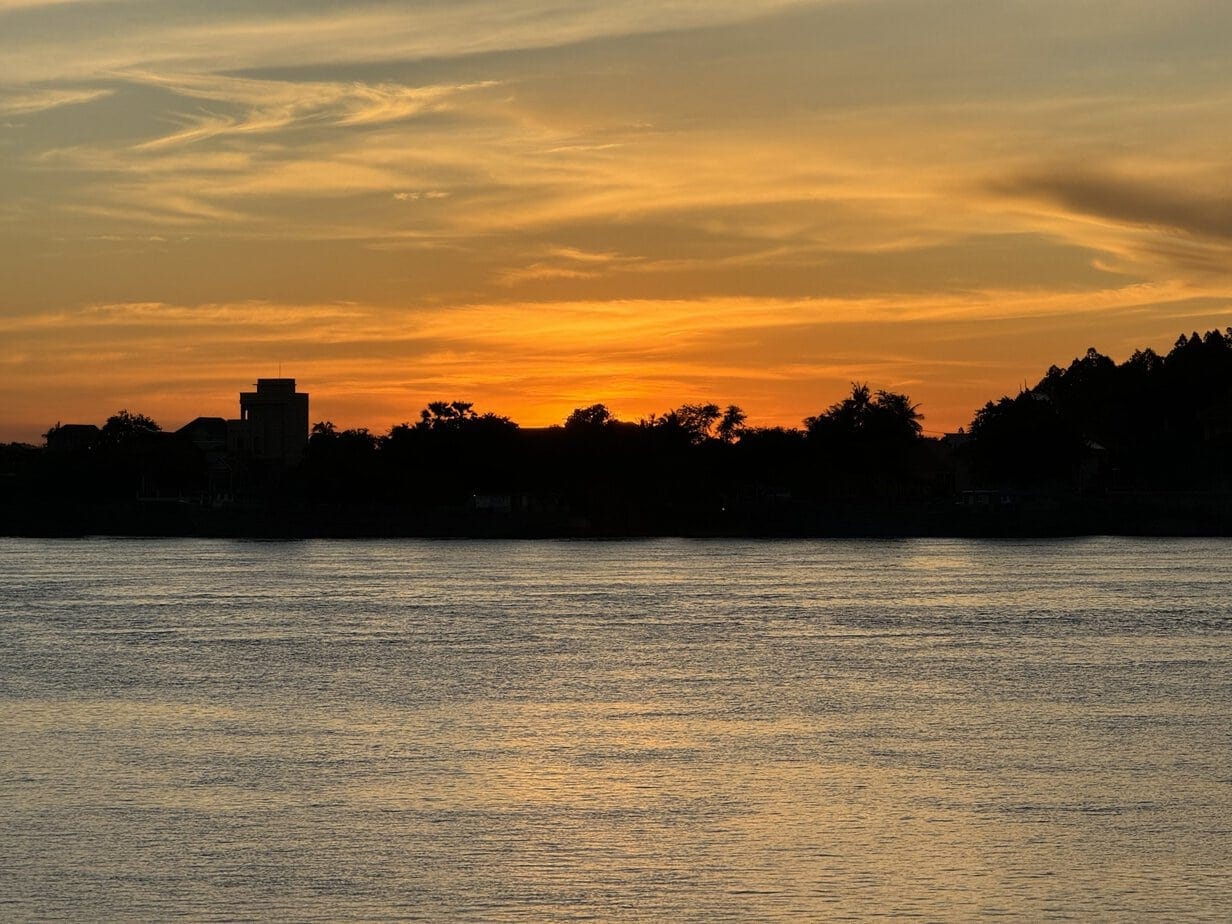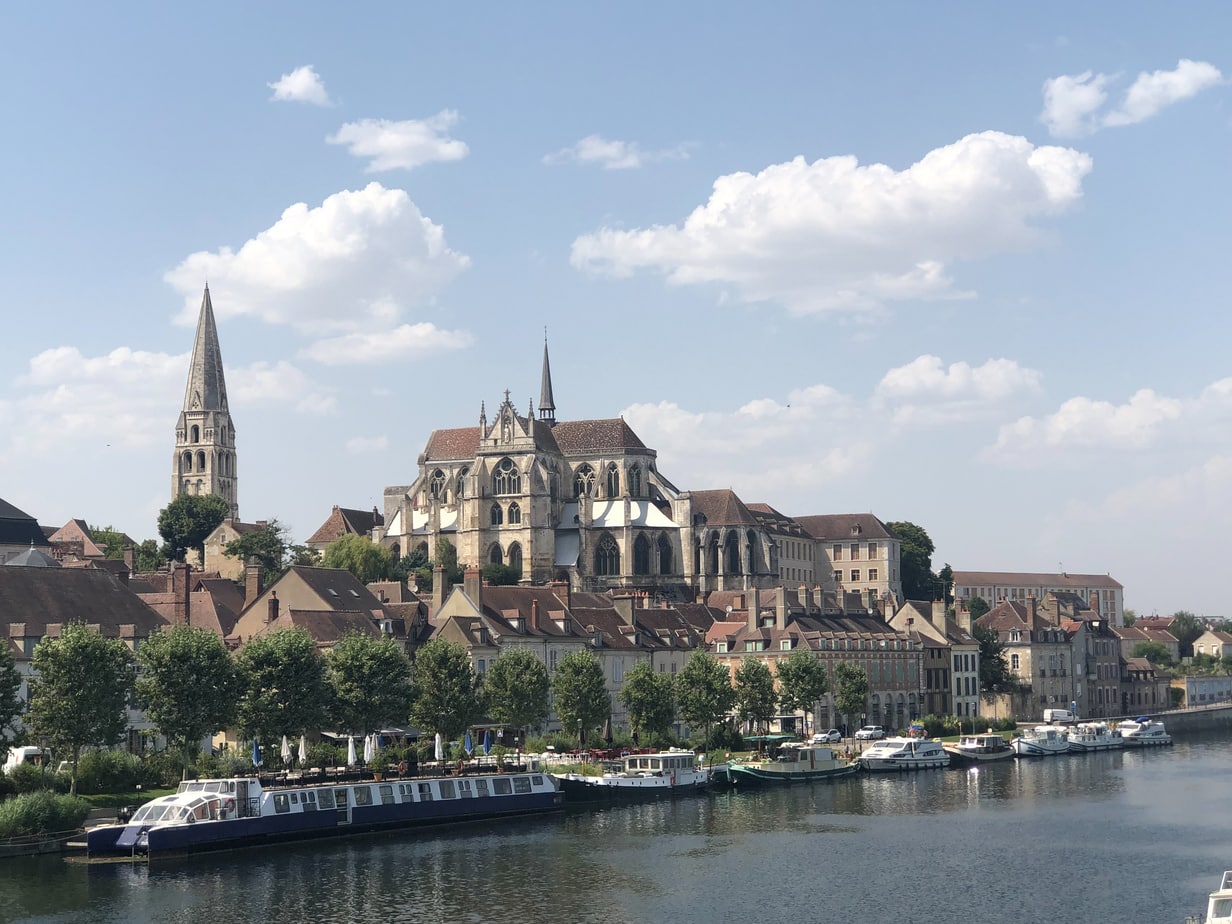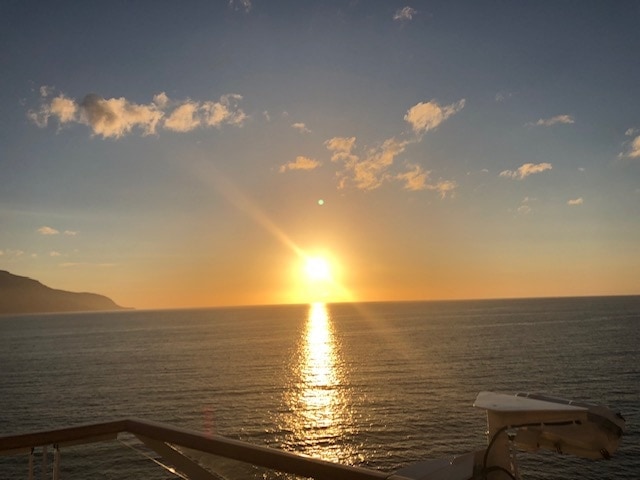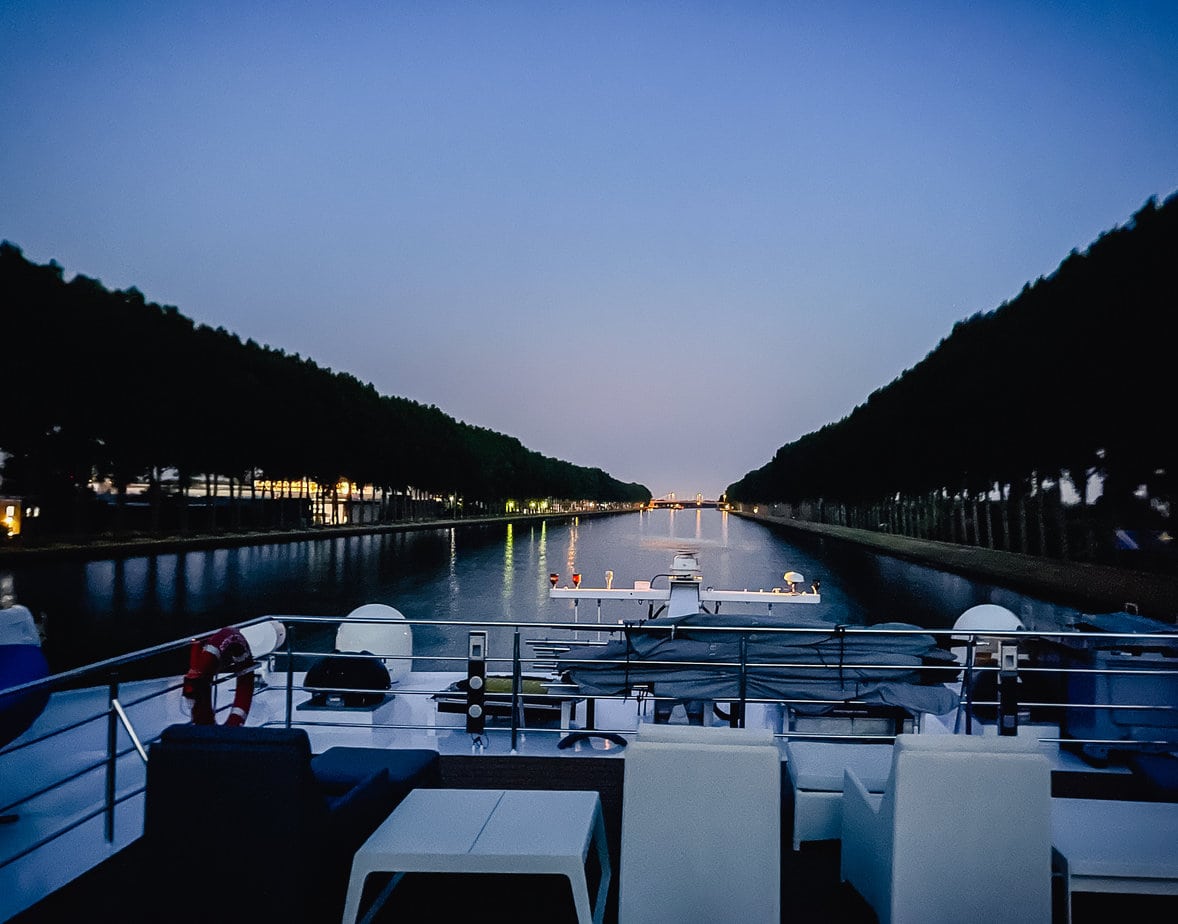The people of Cambodia are warm and welcoming from the moment you arrive. Whether you’re exploring Siem Reap’s markets or taking a boat ride down the Tonle Sap River, or cruising on the Mekong (as we were with Ama Waterways), the Khmer people are always eager to share their heritage and stories with you.
The country has a long history that goes back to ancient times, and its culture reflects that history, drawing on influences from India, China, and Southeast Asia. But Cambodia is about more than just history and culture. The country’s natural beauty is also a major attraction for tourists. From the waters of the Mekong River, to the lush forests, to the beaches of Cambodia’s coastline, the country attracts more than 6.7 million internation visitors a year. And many of those visitors take advantage of the favorable exchange rate and make purchases to take home.
U.S. currency is widely accepted in Cambodia for most transactions, so no need to exchange dollars into Cambodian riel. Credit cards and other contactless payment were also widely accepted.
We like to bring home souvenirs from travel, usually food and other consumable products, along with art for our home. We always prefer to support the local businesses when we shop, and have found street markets and local shops are a good choice for souvenir shopping.
Here are our recommendations for shopping in Cambodia, souvenirs worth bringing home with you.
Foodie Delights
Traditional Cambodian cuisine is similar to Thai food, but with a distinct flavor profile of salty, sweet, spicy, and sour. The dishes and flavors have been shaped by the country’s culture and history, including a long-standing French colonial influence.
Whether shared with others or enjoyed personally, these culinary souvenirs represent a harmonious blend of tradition and innovation, ensuring that the flavors of Cambodia linger long after your visit. These items are Ideal for preserving the tastes of your journey, offering a sensory reminder of the country’s identity. I’ll bet you’ll put many of these on your must-have souvenir list.
Seekers Spirits Mekong Dry Gin
This award-winning artisan distillery celebrates Southeast Asian flavors with spirits infused with rare and unexpected botanicals from the Mekong region. Every batch is made to the highest standards, using the best ingredients sourced from local farmers. Spirits are distilled in copper stills over naked flames, using one of the oldest distillation methods. Seekers Spirits are created in small batches at their Phnom Penh Spirit House by a dedicated team of pioneering distillers.
You may be able to find Seekers Spirits in specialty liquor stores at home, albeit at a significantly higher price.
Mondulkiri Dark Chocolate
WAT Chocolate is Cambodia’s first bean-to-bar chocolatier, using 70% cacao from the Mondulkiri Province and local flavors such as Kampot salt and red chili. The factory is located in the Angkor Night Market (they offer tours in English), with retail locations in Siem Reap and Phnom-Penh. You may also find it on your hotel room pillow.
This chocolate is entirely made in Cambodia, so your purchase helps local farmers and businesses.
Battambang Blaze Hot Sauce
Unleash your taste buds with this delicious and flavor-packed condiment that adds a spicy kick to any dish. This hot sauce is made with authentic Cambodian natural ingredients, ijnclujding locally grown garlic, chilies, and onions. It packs a powerful and tantalizing heat that’s emblematic of Khmer food.
We used it up quickly as it’s unique flavor works well in all sorts of dishes and to make other types of sauces. I’ve yet to find somewhere at home to replace what we bought in Cambodia. Although I’ve come close, I need to spend more time exploring Seattle’s International District to find a shop that carries the real thing.
Kampot Salt and Kampot Pepper
The Kampot pepper is a type of black pepper (piper nigrum) that is grown and produced in Cambodia. It was also known as Indochinese pepper during the early twentieth century when French Indochina was a protectorate of France. The pepper’;s modern name comes from the province where it is grown, Kampot,but its historical name refers to Mainland Southeast Asia in French.

Kampot pepper is grown, produced, and sold in green, black, white, and red varieties, all derived from the same plant. The climate of Kampot Province is ideal for growing pepper, and the quartz content of the fertile soil in the foothills of the Elephant Mountains contributes to Kampot pepper’s distinct terroir. If you appreciate the subtle variations in spices, give this a try. It is available at home (here) when you run out.
There’s also a Kampot sea salt, which comes from the coastal Kampot and Kep provinces. The high quality salt is harvested in small quantities only during April and May. I regret that we didn’t bring any home with us as as we’ve come to appreciate the differences is salts.
Spice Mixtures
Popular Cambodian herbs and spices, such as the aromatic Kampot pepper, are carefully mixed and blended and make for great souvenirs and delicious gifts. The spice mixes provide a nuanced introduction to Khmer cuisine by capturing authentic flavors through skillful blends of locally sourced ingredients.
You’ll find spice packages in various markets at affordable prices, so don’t be afraid to give something unfamiliar a try. Many of the packages include recipes for adding traditional Cambodian flavors to rice dishes, soups, and curries with premixed herbs and spices. With each use, Kamrikan, lemongrass, and Kampot pepper blends will remind you of the vibrant markets and family kitchens from your visit.
Palm Sugar
Palm sugar is a sweetener made from any type of palm tree. It’s sometimes classified according to the type of palm, such as coconut palm sugar. While sugars from different palms may differ slightly in composition, they are all processed similarly and can be used interchangeably. The taste is a little like brown sugar, although not as sweet, with a hint of caramel flavor.
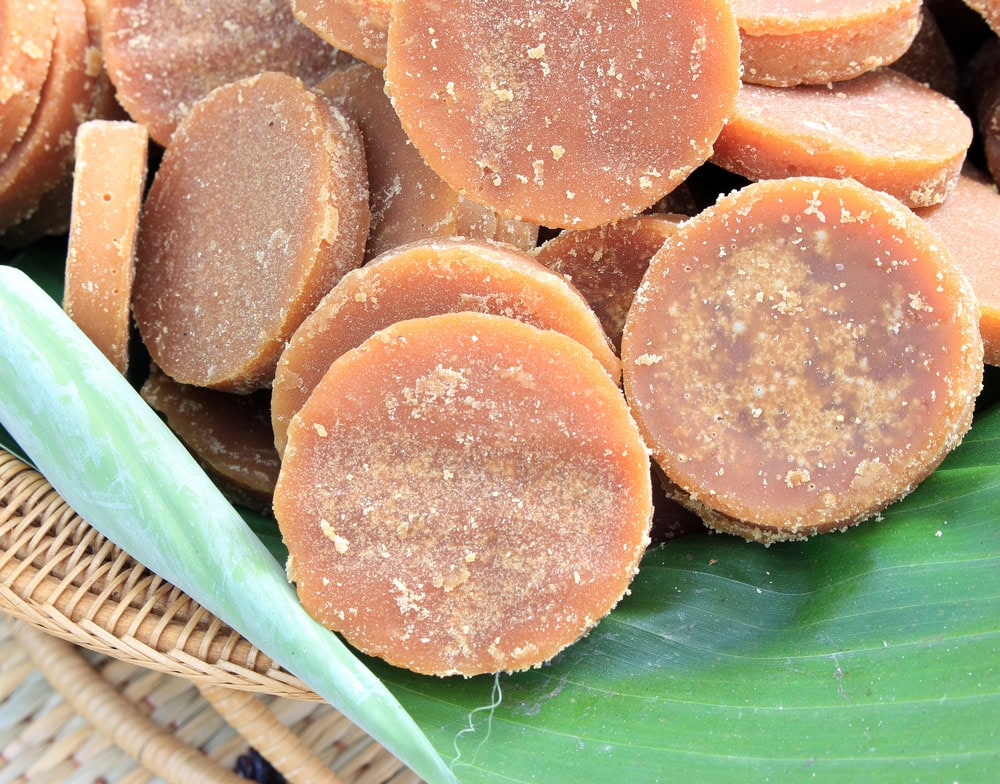
You’ll generally find palm sugar shaped light brown round discs, then packaged by weight. You can also find in in darker brown brown small cubes (often called jaggery. It’s similarly packaged, but you’ll also see in served on the table with coffee or too. If you use sugar in your coffee or tea, try this substitute. You’ll find it a bit sweeter than refined sugar, and can use less.
Rice wine (sra sor)
Sra Sor is a rice wine steeped in tradition and full of flavor. It’s more than a beverage; it’s a testament to generations of traditions, a gateway to vibrant celebrations, and a symbol of resilient local pride.
At the heart of this is the choice of rice. While the fragrant, whole Souv Krohom variety speaks of tradition, some craftsmen find harmony in broken rice blends that tell stories of resourcefulness and adaptation. Rice wine is popular in much of Asia, including Japan (sake) and Vietnam, but the rice used in Cambodia gives it an ever so slight difference.
Sra Sor, which contains between 20% and 50% alcohol, is a popular drink at weddings, funerals, and festivals. If you’re visiting with locals, you may be offered a glass of home brew, but if you want to take some home, buy a sealed bottle from a reputable store.
Coffee
While Southeast Asia coffee is often associated with Indonesia and Vietnam, Cambodia is emerging as a coffee-growing region. Although the number of coffee plantations have dropped off over the past few years, those remaining are dedicated to the craft, from bush to cup
The most well-known brand is Mondulkiri Coffee, which continues a coffee-growing tradition begun by French colonialists in the 1700s. A traditional method for preparing Cambodian coffee (as well as other Southeast Asian coffees) is to roast it until it is nearly black with vegetable fat. After the coffee beans have been roasted, they are ground into a fine powder that brewed with a cloth sock-like sieve or coffee filter to make a rich, dark cup of coffee. The coffee maker itself is quite a contraption, sort of a cross between an espresso maker and French press. I regret I didn’t get a photo or video when it was being made.
You’ll find this robusta coffe in shops in Cambodia and Phnom Penh. This coffee is much harder to find at home, so stock up for yourself or treat your coffee lover pals to a special gift.
Local Crafts and Specialties
One of the easiest ways to buy local is by directly patronizing local artisans and crafts people. Here are some suggestions of items that make great Cambodian souvenirs or gifts.
Handwoven Bags
Handwoven bags are an important part of Cambodian culture and heritage, and are typically made from natural fibers like silk, cotton, or rattan. They come in a variety of styles, including totes, clutches,and backpacks, and are often decorated with vibrant colors and intricate patterns. Traditional techniques are passed down through generations, and many artisans prioritize sustainability by recycling materials and using environmentally friendly materials and methods.
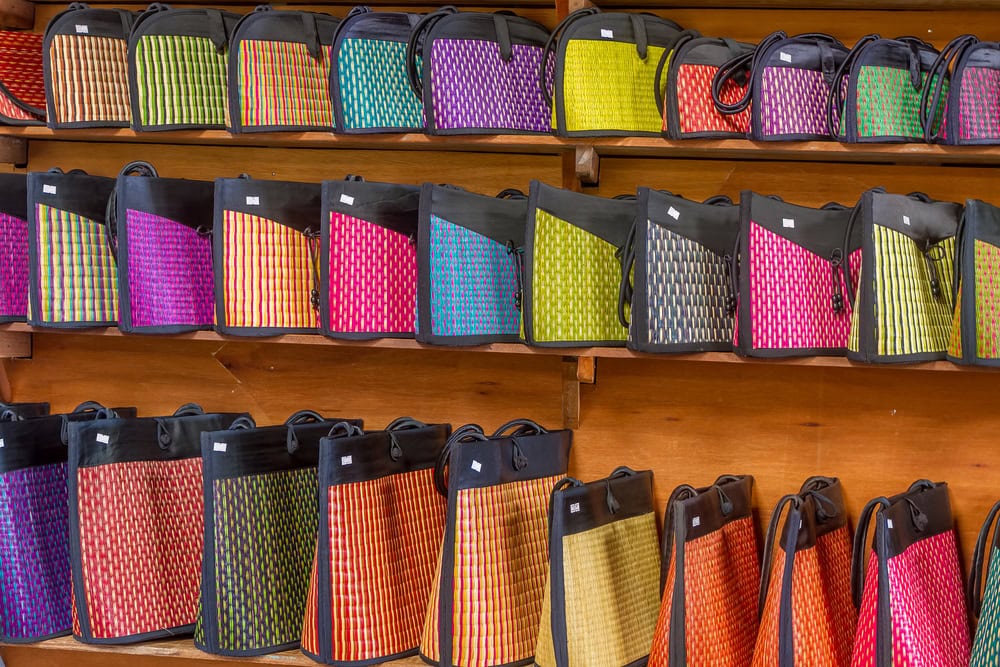
You’ll find bags at the luxury end in upscale shops in Phnom Penh, but I think you’ll find local markets to be a perfect place to find a good selection and to support the local people.
Lotus Flower Products
The lotus flower has a special significance in Cambodian culture, representing purity and enlightenment. The petals of the lotus flower are used to make beautiful specialty products like soaps, candles, and essential oils. These products not only make excellent souvenirs, but they also benefit local communities, as many are produced by womens cooperatives.
Lotus flower products are available in Cambodian markets and shops, and you can learn how to make your own lotus soap at the Lotus Farm in Siem Reap. I like buying directly from the artisan whenever possible, and in many markets you’ll see the maker directly selling. You’ll find upscale lotus flower items in many hotel gift shops and upscale stores.
Espadrilles
The espadrilles are a must-have for the Cambodian way of life, and you’ll see locals wearing them everywhere you turn. Handmade from cotton fabric with a jute sole, they are suitable for any occasion from working in the fields to working in a shop and greeting guests. Look for ones made from Krama, a traditional checked-pattern fabric often made by rural families, or upcycled/recycled fabrics. At some shops you can create your own design.
I can’t emphasize enough the importance of looking for local, ethically made espadrilles. Look for sustainable local brands using quality materials produce and sold in Cambodia. You’ll find lots of small businesses that have adopted fair trade practices who pay fair rates and treat workers well. These are not the fast fashion of sweatshops.
I wish I had bought a pair, but I was distracted when we visited the Central Market.( A reason for a return trip, perhaps?)
Handwoven Scarves
Two choices here, both handwoven, in either cotton or silk. Both are solid choice, it all depends on your personal preference.
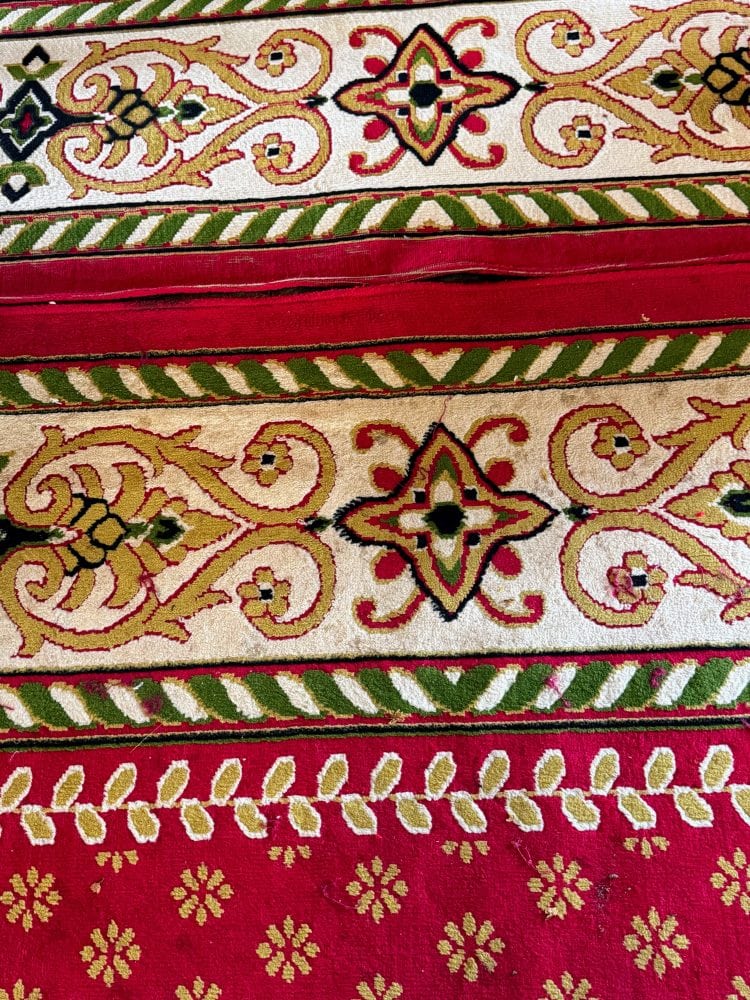
Cambodia has a long history of silk weaving. We saw silk weavers in action on an excursion to Silk Island on our Ama Mekong cruise. Later on, we had the opportunity to buy silk products at a craft center in Oudong. I picked up a couple of vibrant scarves (along with a decorative pillow cover that’s on my office couch as a touch of Cambodian charm) as a fond reminder of our visit to Cambodia.
Traditional cottom krama scarves are also widely available. While the originas of Krama is unknown, today it’s an important part of the Khmer identity. You willl see them every, in all sizes, incuding ones large enough to be used as a beach cover (like a sarong or pareo) or towel. There are cooperatives that focus on fair trade and providing emplyment opportunities for women from rural areas of the country. Look for that option, if you can. I’ve found this website for ordering Cambodian cotton scarves at home.
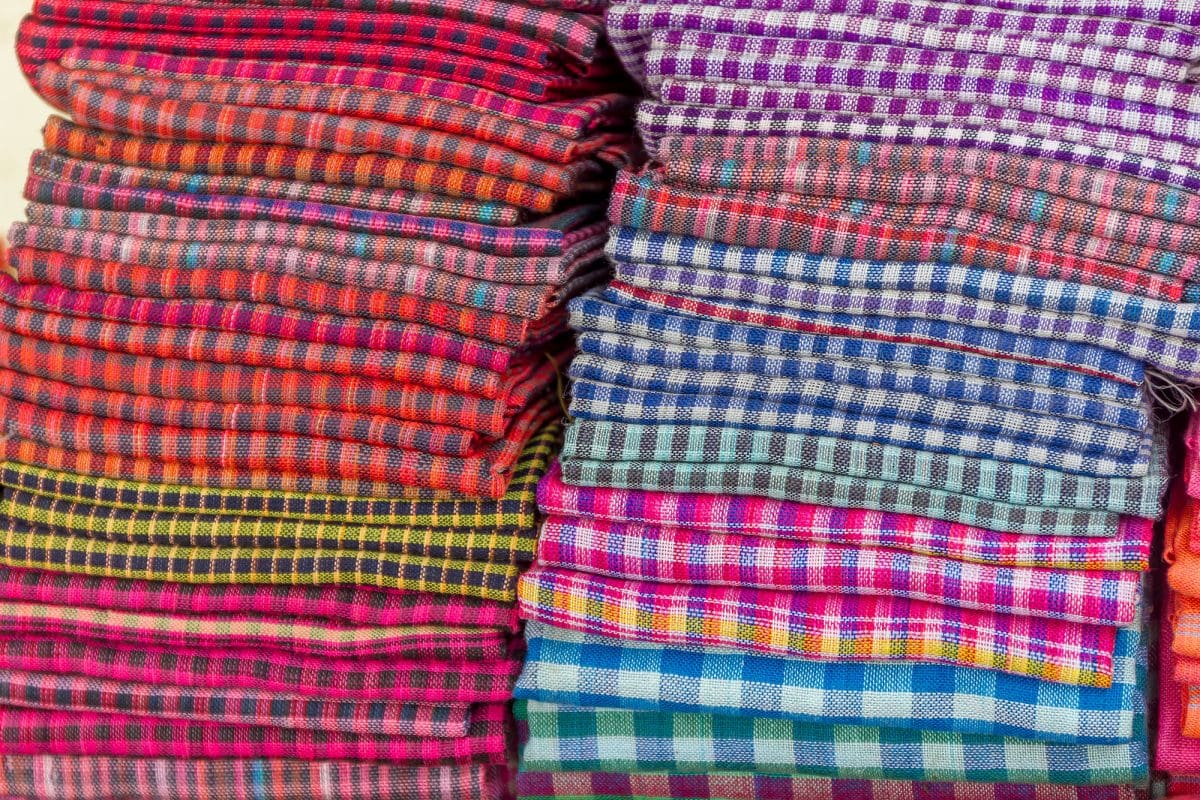
Skin Care
If you have enjoyed a spa service, you’ll find the Cambodian products and scents a real treat, With native herbs, plants, and minerals crafted into natural organic products, many claim the products relieve headaches, dizziness, skin conditions, and sprains.
I make no such claims. But I do love the body balms and soaps for relaxation and fond travel memories.
Blessing Bowls
In Cambodian pagodas, blessing bowls represent the sacred and are used in rituals of worship and devotion. They are used to express gratitude and make offerings of food, flowers, incense, and water. They are a part of daily Buddhist rituals, and are also used to bless ceremonies and special occasions. Monks use them to pour water over congregants during blessing ceremonies as a way of invoking good fortune.
You can purchase bowls, or a blessing bowl candle (which takes us much less room in your luggage). Try incorporating this ritual into your own mindful practice.
Bayon Wood Puzzle
The design for this puzzle made of wood carvings is inspired by the smiling stone faces at Bayon Temple at Angor Thom. Also known as Prasat Bayon, it is a well-known and richly decorated Khmer temple built in the late 12th or early 13th century. You can purchase a puzzle on the grounds of Angor, or in Phnom Penh where there is a studio and you can watch the master carvers at work.
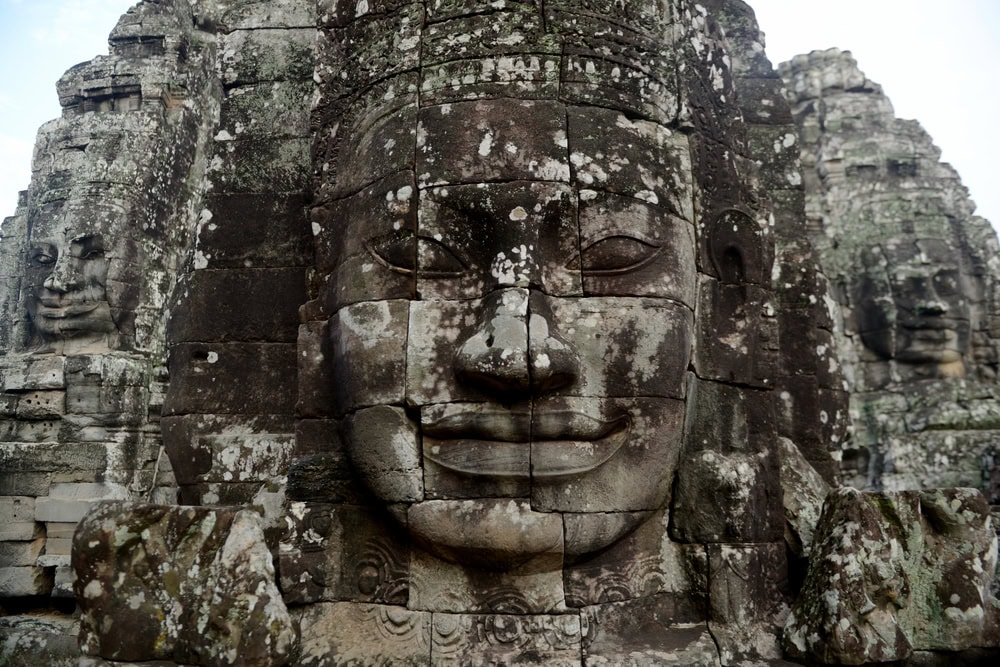
If you feel you missed out on getting a puzzle, you can get a traditional jigsaw puzzle (1,000 pieces) here. When we have family and friends weekend getaways, we like to throw in a jigsaw puzzle. This one may make the cut this year.
Lacquerware Boxes and Trays
Lacquerware, lovely pieces of home goods with intricate inlays depicting natural and cultural motifs, are a traditional Cambodian craft. They are carefully decorated with inlaid mother-of-pearl designs portraying landscapes of Angkor Wat temples and scenes from rural Cambodia. Intricate inlay pieces often feature delicate florals and symbols of Cambodian cultural traditions.
Available as furniture, bowls, vases, bowls, and decorative art. Look for quality pieces, not cheap knock offs, at galleries, upscale shops, and lacquerware studios.
Ikat Products
Ikat is a traditional dyeing and weaving method used in many parts of the Asia. In Cambodia, ikat patterns were traditionally reserved for fine silk fabric, but you know find it use on cotton. The design element has sort of softness (often described as bluriness) to it, rather than sharp crisp lines. The weaving art was nearly destroyed during the terror of the Khmer Rouge, with weavers killed or simply disappearing. Since 1995, an effort has been made to teach and continue the art of ikat, keeping the art alive.
Traditional ikat purchases are a robe and sampot (see details on that below).
Sampot
A sampot, or long, rectangular cloth worn around the lower body, is a traditional form of Cambodian dress. It dates back to the Funan era, when a Cambodian king ordered his people to wear it in response to Chinese envoy requests. Complex methods and intricate models have been developed to create the cloth used for sampot, silk ikat being the most preferred.
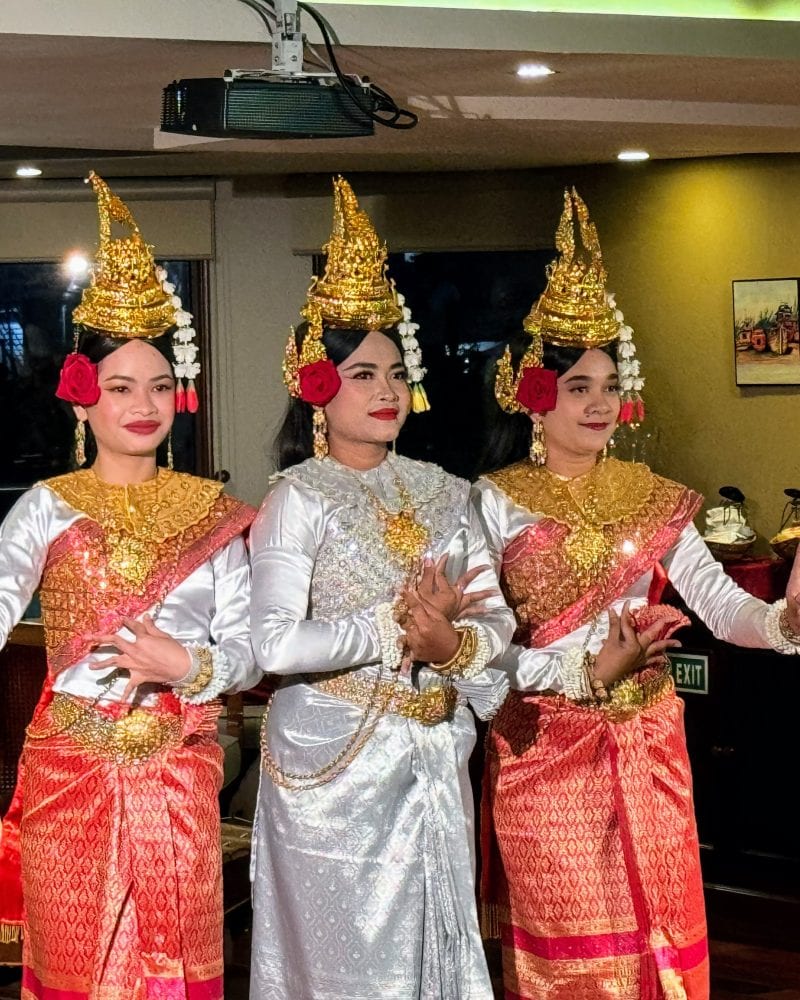
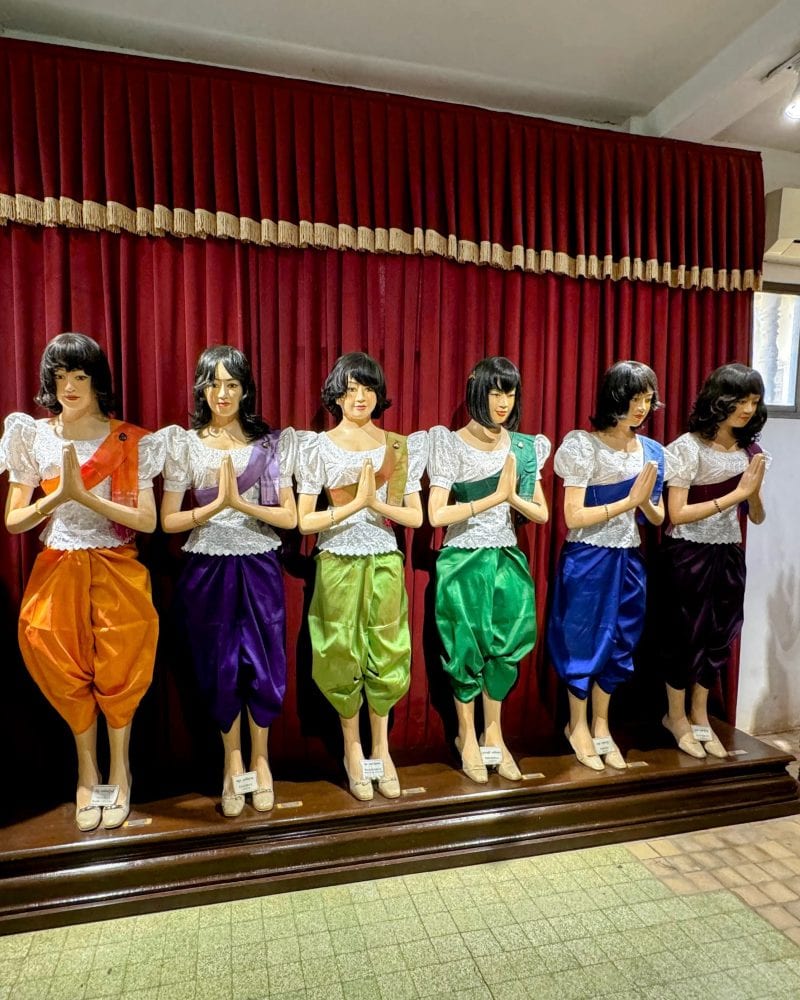
The sampot can be draped and folded in numerous ways, wrapped around the waist to cover the stomach, then tied in front. The fabric is then pulled up between the legs, fastened with a belt, until it resembles more pants than skirt. It is often paired with a Chang Pong, a colorful cloth worn drqaped across the shoulder that covers the chest.
A sampot like outfit is also worn in neighboring countries like Laos and Thailand, where it is called pha nung.
Khmer Kites
Khmer kites are both flown and used as home decor, and are believed to date back to around 400 B.C. Historically, they were used on a variety of occasions, such as celebrations, religious rituals, and as storytelling. These kites have vibrant colors and intricate designs, frequently depicting animals, mythological figures, or scenes from folklore. They make a humming noise when they’re flown,
These are delicate items, so plan on careful packing.
If you love kites and the history behind them, you’ll enjoy the Khmer Kite factory in Phnom Penh.
Silk
A very short drive from Siem Reap is the Silk Road, running near the ancient city of Angkor. It leads through rural villages, past lush green rice paddies, and into the heart of what was once the country’s sericulture (the growing of silkworms to produce silk) and weaving industry. Cambodian golden silk is made from the cocoons of golden silkworms, not white ones found somewhere else in the the world, which have adapted to the warm tropical environment of northern Cambodia and feed on a local mulberry.
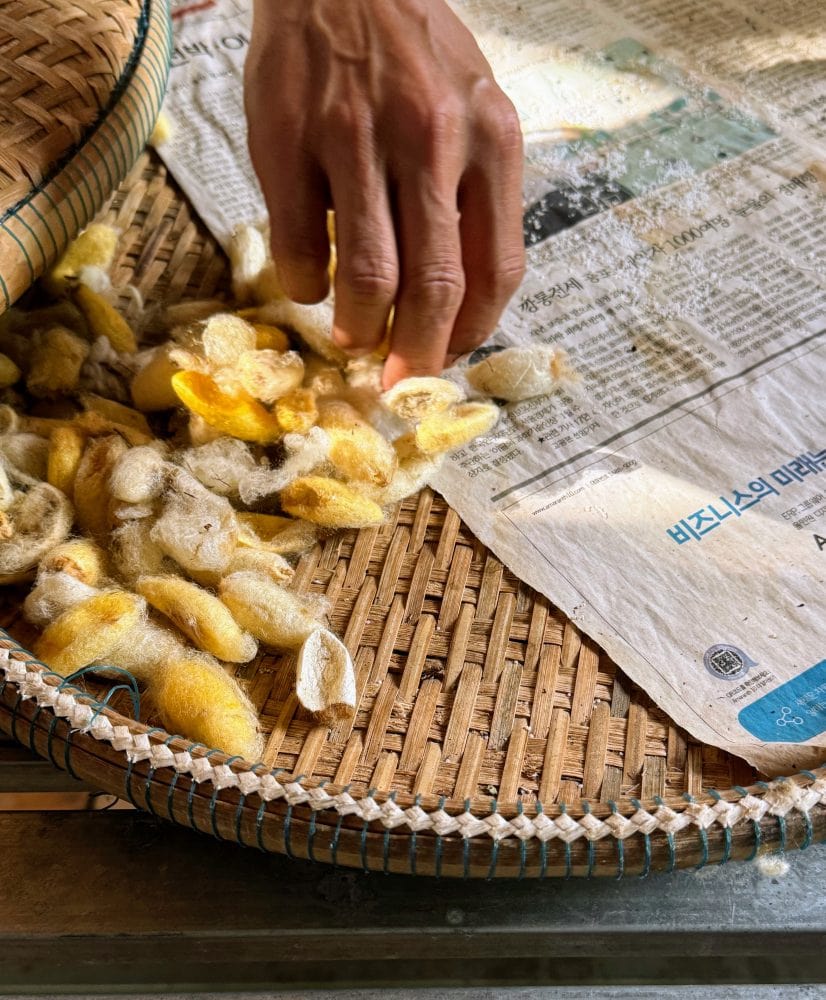
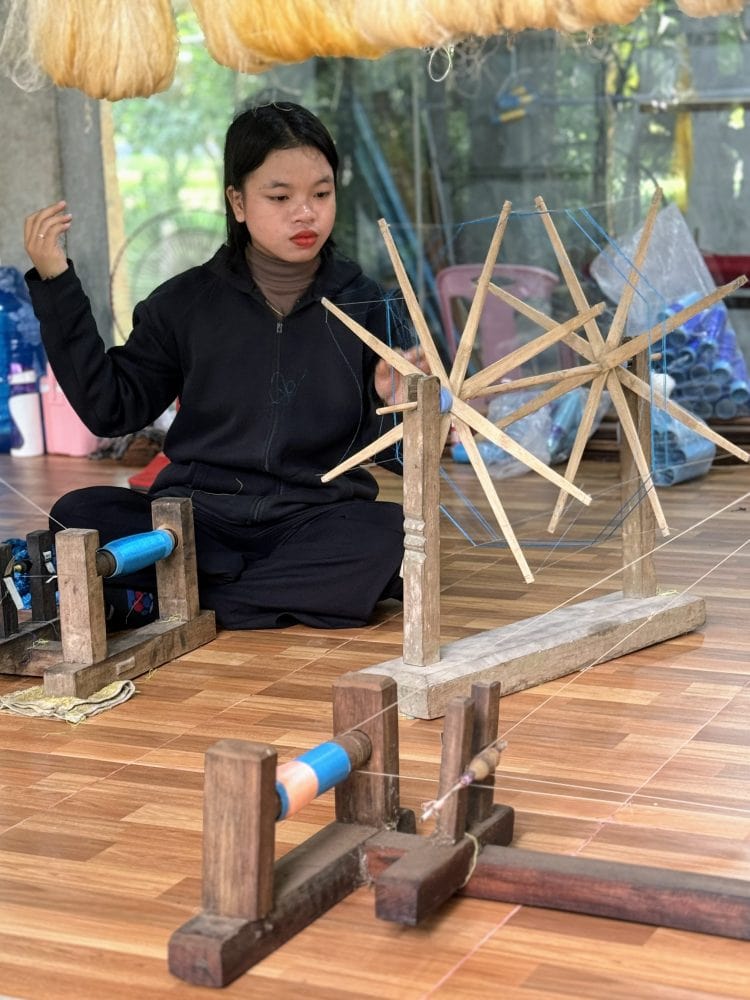
I’ve mention silk scarves above, but the abundance of silk products goes beyond scarves. You’ll find all types of clothing, home decor items, artwork, and even yards of fabric. Higher end silk items can be found in upscale boutiques, and every day silkwear and products can be found in cooperatives and smaller shops.
Silver
Silversmiths are abundant in Cambodia, an art form dating back to the 6th or 7th century. Historically, silver jewelry denoted identity and status, although it has been more egalitarian in modern times. Silver bowls, boxes, and other decorative ornaments, were a much coveted part of any home.
Buy directly from the craftsmen when you can (there are silversmith villages), or from reliable shops.
Musical Instruments
Traditional Cambodian musical instruments include a diverse range of wind, string, and percussion instruments.
- Cambodia Takhe – A Takhe has three to five legs. When performing, the player sits beside it, with the left hand running up and down the strings and the other plucking them with a plectrum.
- Cambodia Chapei Dang Veng – A solo instrument used by musicians to tell folk stories during traditional wedding ceremonies.
- Cambodia Kse Diev – Also known as Sadiev, this is thought to be one of Cambodia’s oldest Khmer musical instruments.
These make great decorative pieces, just in case you don’t plan on learning how to play.
Coconut bowls
The greatest part about coconut bowls, aside from being environmentally friendly, is their versatility. They are ideal as plant holders, for use at the beach and BBQs, for storing makeup and soaps/towels in the bathroom, and for a variety of other uses. They are lovely and do not break easily, so can survive your luggage.
Find these colorful bowls in markets as well as souvenir shops. They’re inexpensive (under $5 when we were there, 3 for $10). I thought they’d be awkward to pack, so passed, but lnow I ook around the house and see all sorts of things I could use them for. They’re prettier and cost less than many of the plastic pieces I use in the ktichen and bathroom.
Mala Beads
Mala beads, also known as japa malas, are used by Buddhists and Hindus to help promote mindfulness during meditation and prayers. They are also used as part of a yoga practice.
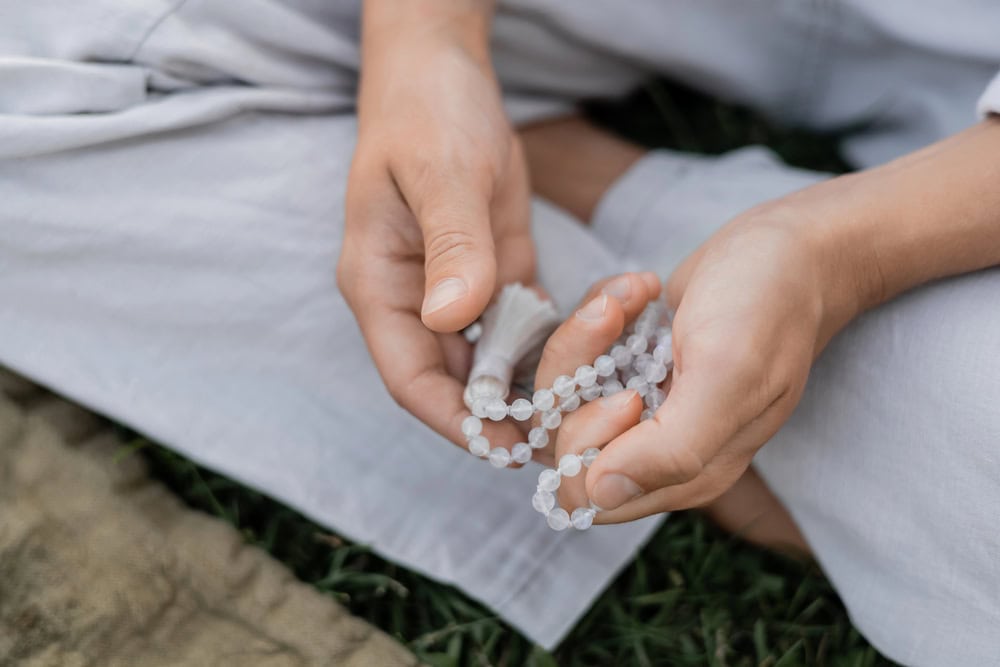
One mala contains 108 beads, each one helping with mantra repetition, helping to maintain foucs and consisten breathing during meditation.
Masks
Masks have been a popular wall decorations for years, but I hadn’t seen Cambodian masks before.
These handmade, brightly colored masks, are used in Khmer theaters and dance performances dating back to the Angkor period. During the ceremonies, the performers wear masks that represent characters. The masks are used for four different roles in the performance: neay rong (male), neang (female), yeak (ogres or asuras), and sva (monkey). Apsara crowns or headdresses indicate the rank of the characters. The smallest crowns, such as the kbang, are worn by lower-ranking characters, whereas divinities wear tall crowns known as mokot ksatrey. These theatrical masks are revered and treated with great respect.
Palm Leaf Art
Palm leaves are used to make a variety of products, including presentation boxes, hats, trays, baskets, and more. The weaving of these items is simple, and the twists and turns of the palm leaf strips used to construct each product vary slightly. You can find reasonable prices in local markets and art quality pieces in specialty stores, handicraft boutiques, and galleries.
Recycled Bombshell Products
I debated about whether to include this item on the souvenir list or not, as it falls into the tchotchke category. But the background behind these tchotchkes is our history, and many of these items are part of larger social enterprise projects.
During the Vietnam War (or the American war as it is called there), Cambodia was heavily damaged, leaving millions of unexploded bombs. These bombshells are now being dismantled and re -purposed into jewelry, bottle openers, keychains, and other classic souvenir items, with proceeds supporting organizations that work to clear landmines and assist affected communities.
You can find recycled bombshell products in Cambodian markets and souvenir shops. The best place to learn more about the big picture of this effort is at the Cambodian Landmine Museum in Siem Reap.




